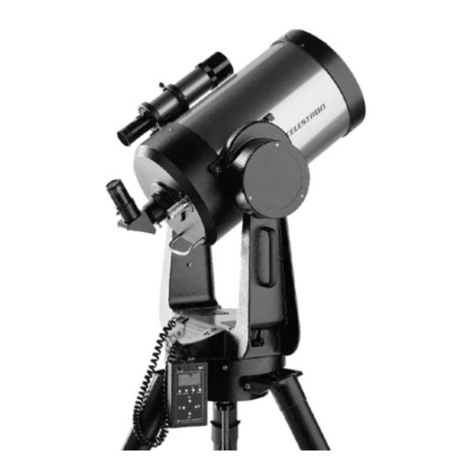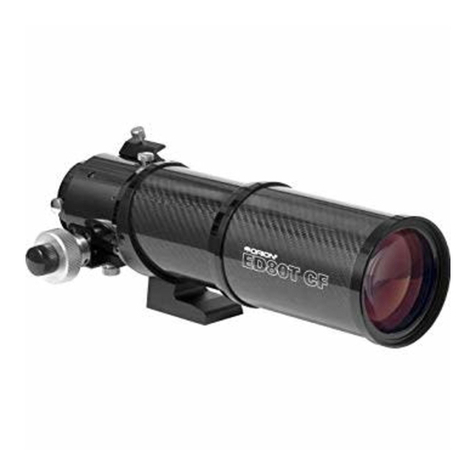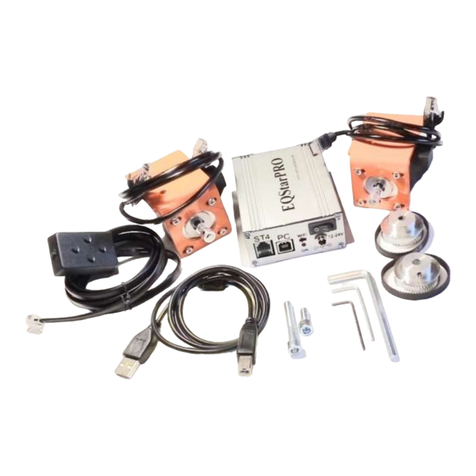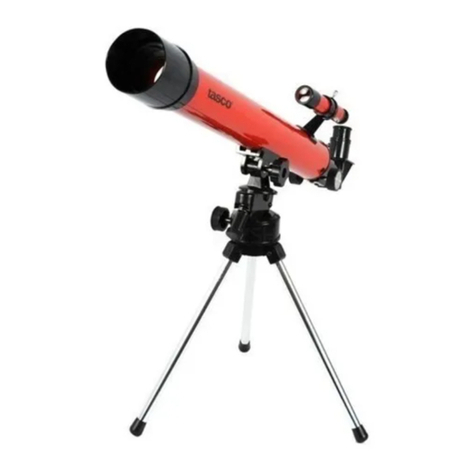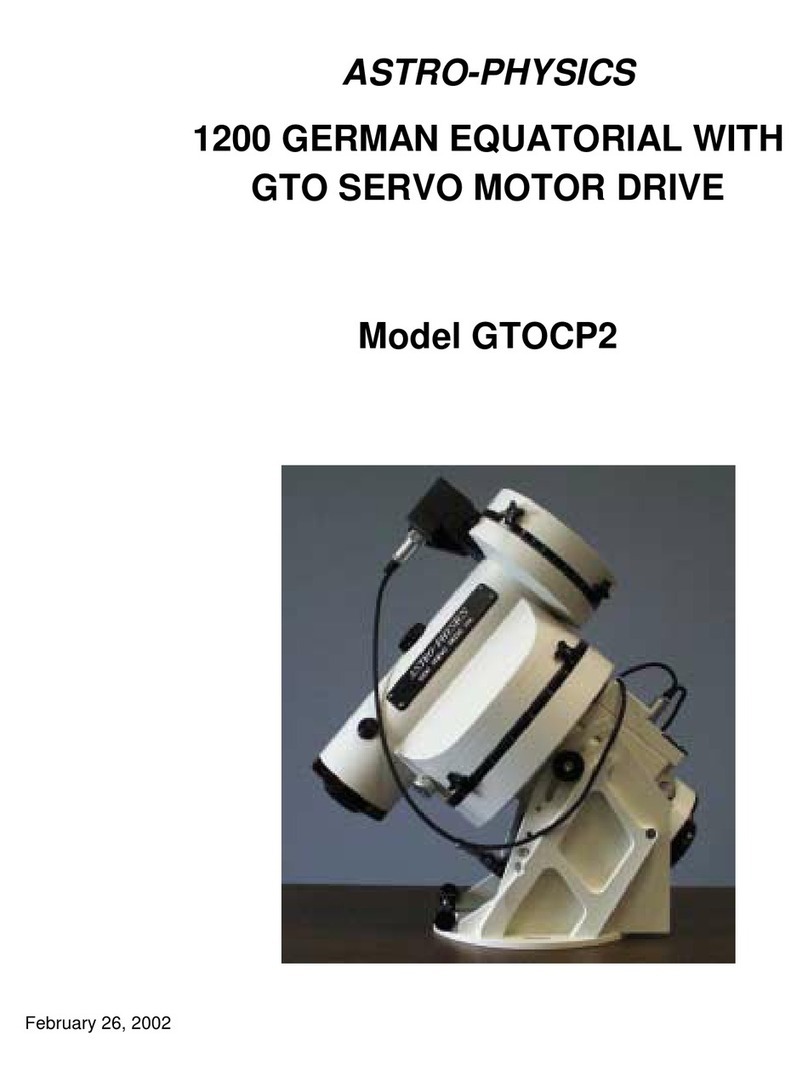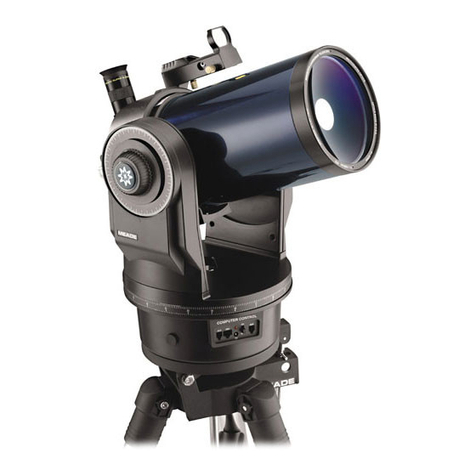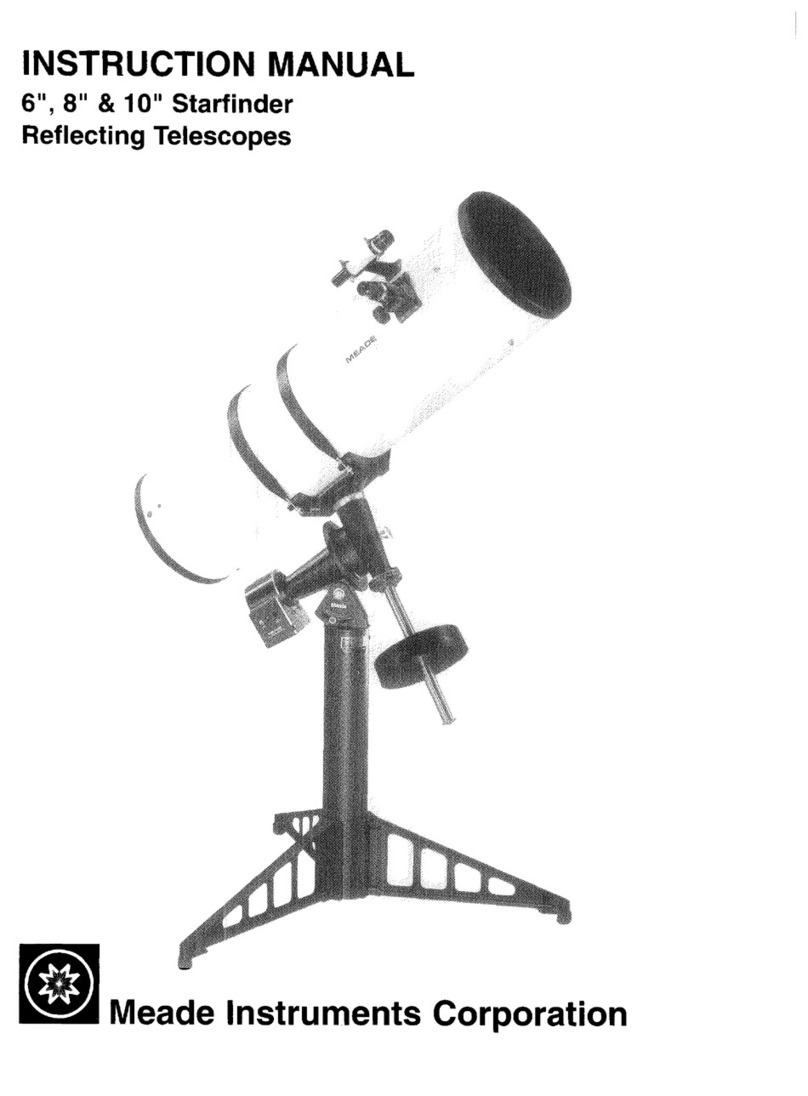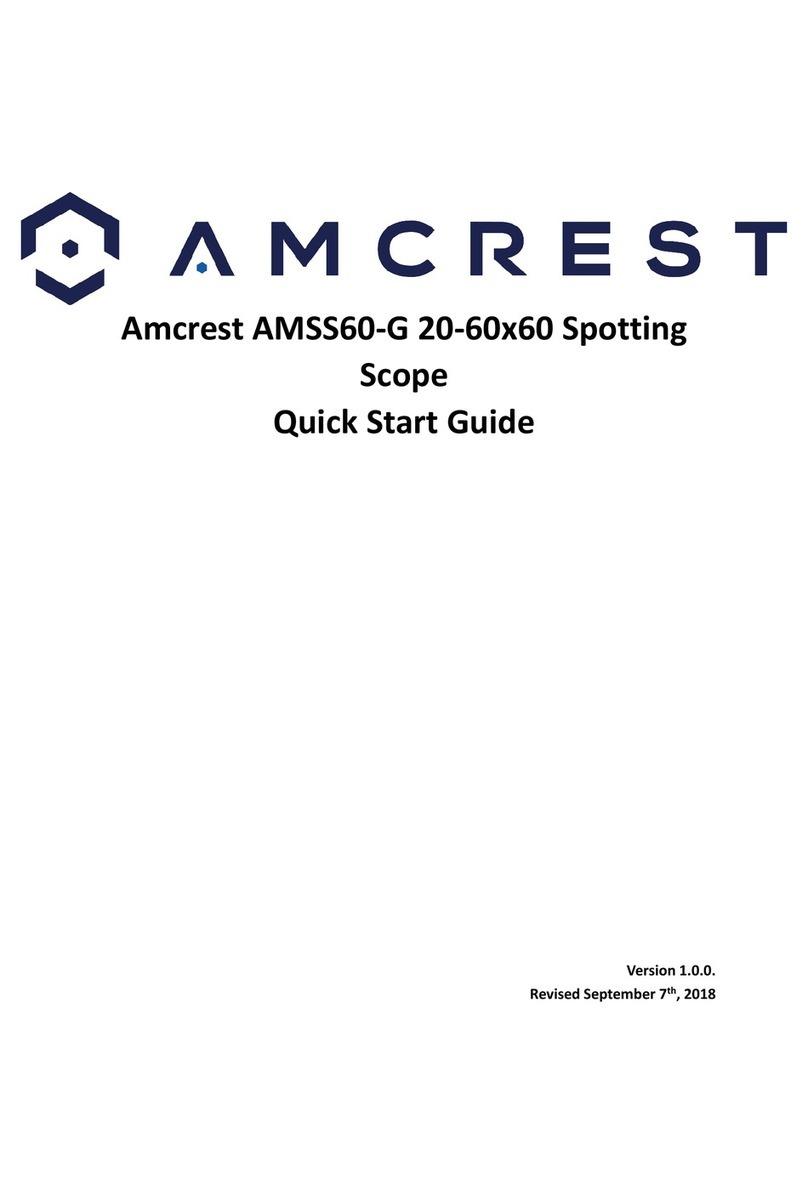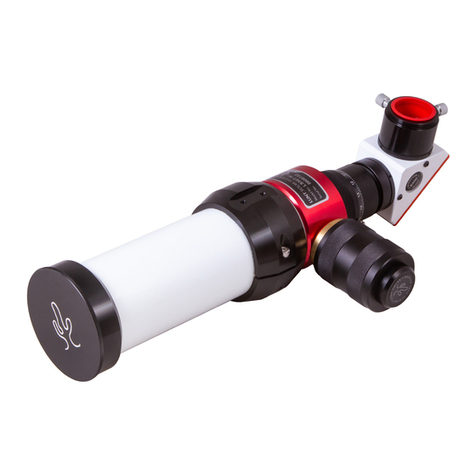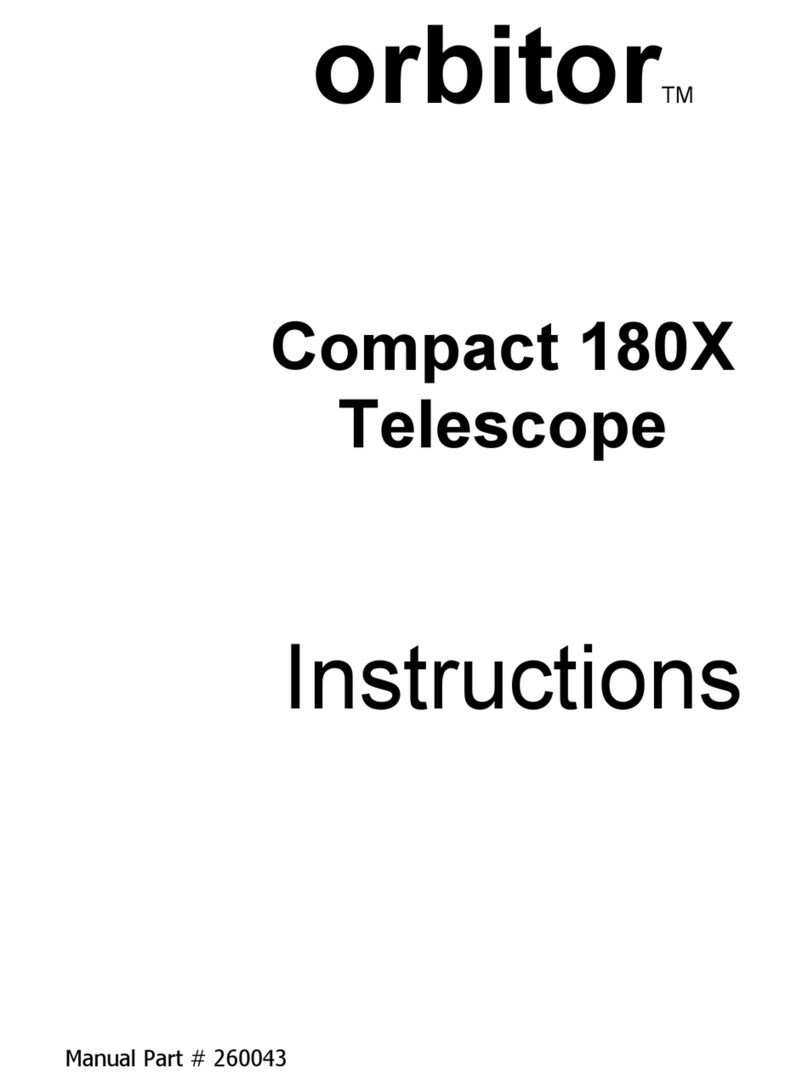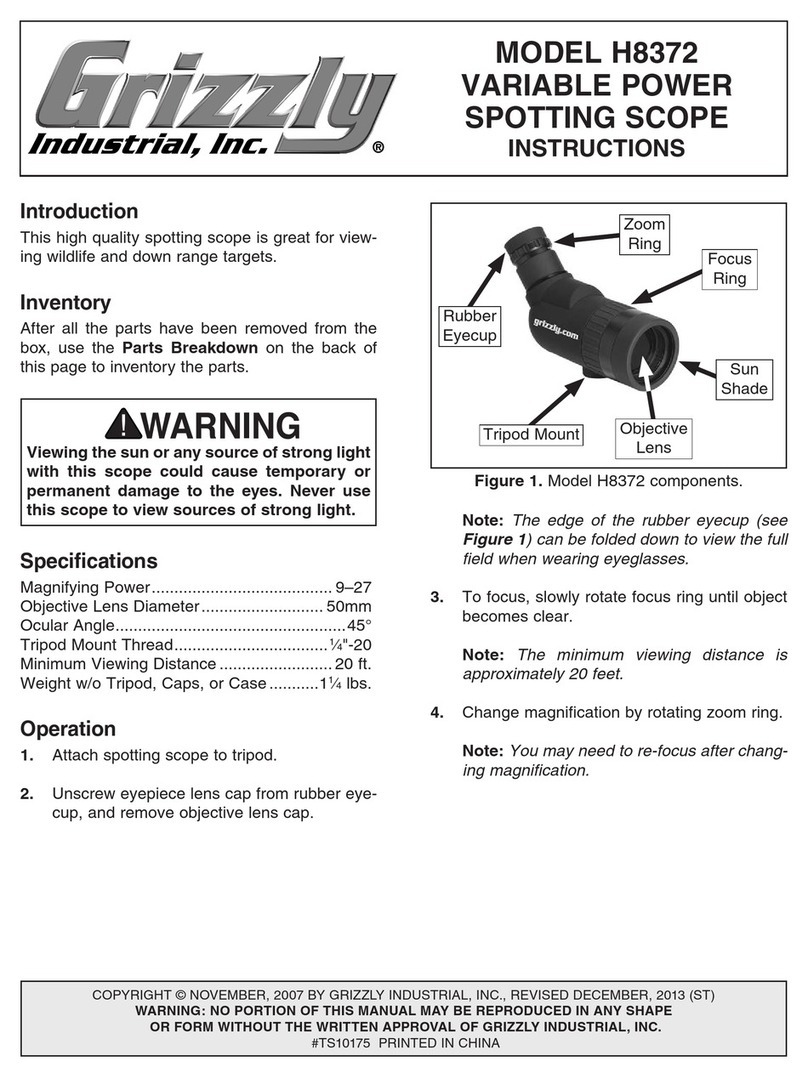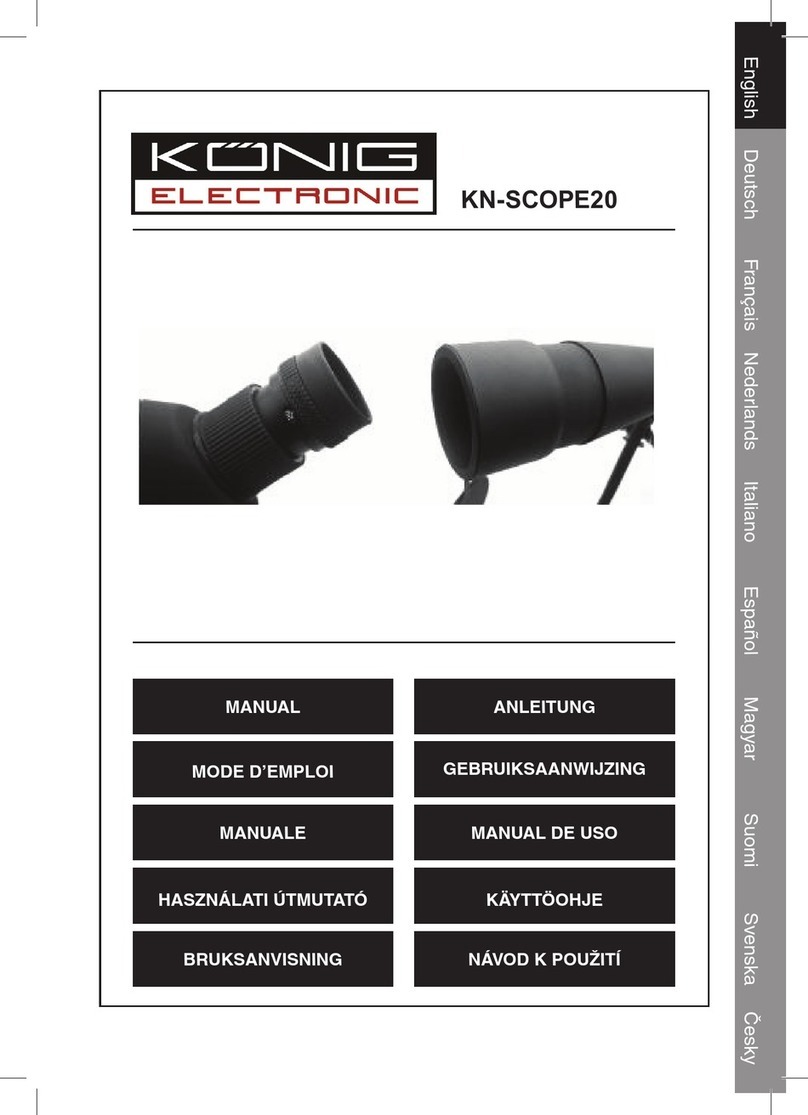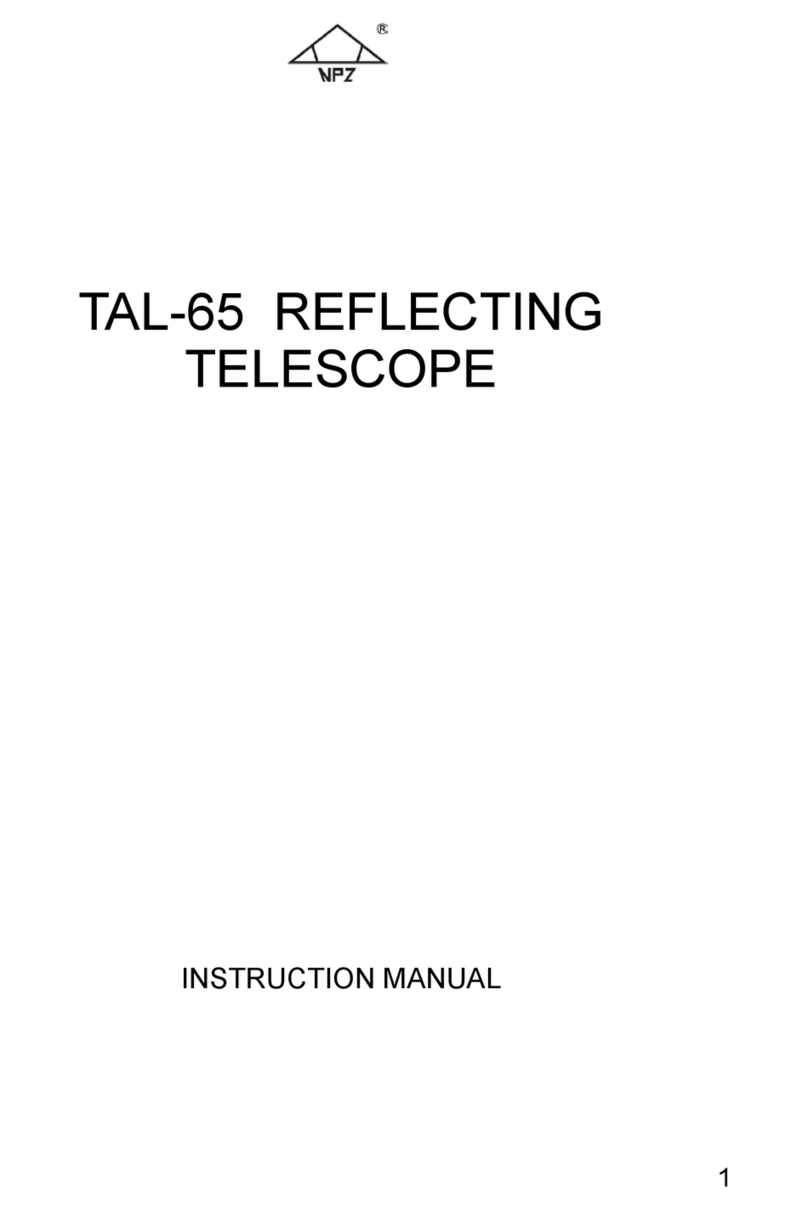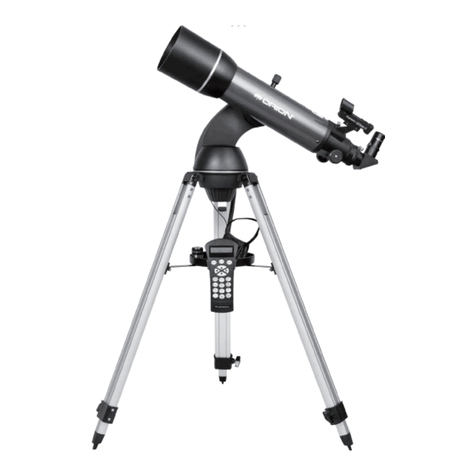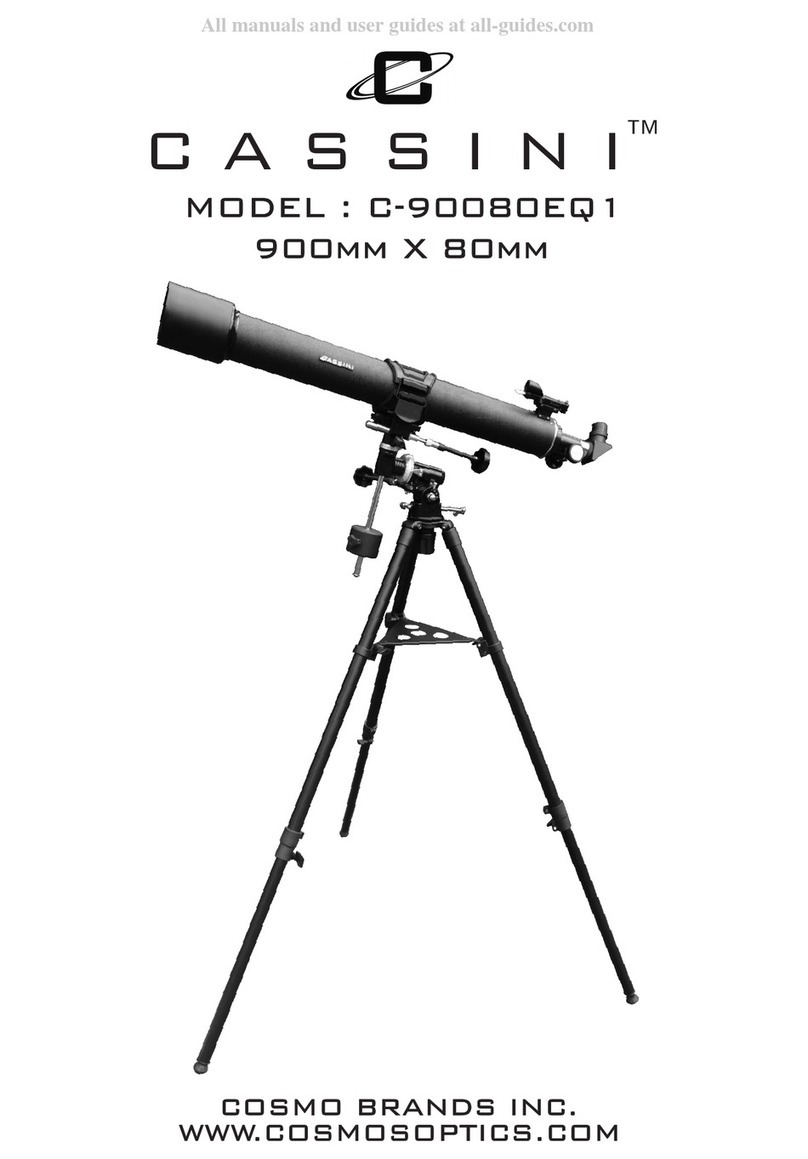Stellarvue SVX80T-25SV APO TRIPLET User manual

STELLARVUE
STELLARVUEC
TELESCOPE OPERATORS ANUAL
SVX80T-25SV APO TRIPLET
A Division of Auburn Precision Optics
WWW.STELLA VUE.COM
11802 KE PERROAD, AUBURN, CA 95603 U. S. A
PHONE (530) 823-7796, FAX (530) 823-8121
STELLARVUE
STELLARVUEC
SEEING IS BELIEVING
The mission of Ste arvue is to inspire a hea thy interest in science
and astronomy by handcrafting the finest te escopes on the p anet.

Table of Contents
Section Page
A message from Vic Maris............................................................................ 2
Making world class optics........................................................................... 3
Whats inside the box.....................................................................................4
Attaching the telescope to the mount............................................................5
Setting up for visual use................................................................................6
Eyepieces and seeing conditions................................................................ 7
Observing tips............................................................................................... 8
Accessories chart......................................................................................... 9
Reflex sights..................................................................................................11
Optical finder scopes.....................................................................................12
Solar viewing................................................................................................ 13
Astrophotography.......................................................................................... 14
Photographic field flatteners........................................................................ 15
Other Items needed for Imaging................................................................... 16
The focuser................................................................................................... 17
Care and maintenance................................................................................. 18
Warranty....................................................................................................... 19
Solar warning............................................................................................... 19
1

A MESSAGE F OM STELLA VUE FOUNDE VIC MA IS
When I was a child, I developed a love for astronomy. My parents wanted
to encouarge my interest, so they bought me a 60 mm refractor. Like many
store-bought telescopes it was poorly made, showed very little detail, and
was difficult to use. I struggled for months and became very discouraged.
Then, I learned it was possible to make a telescope. Using my allowance, I
saved and purchased parts, ground and polished a 6” mirror,
and made my first handcrafted telescope.
At the age of 16, I went on to grind and polish a two-element, 5” achromatic lens. I learned a great deal in
these early years and discovered first-hand the importance of excellent optics combined with mounts that were
mechanically stable. Viewing the night sky using my handcrafted telescopes fed my interest, and inspired me
to continue learning more about astronomy and making telescopes.
Realizing that there was a need for high-quality refractor telescopes on the
market, I began Stellarvue in 1998. We have since invested in computer
numeric controlled equipment and a state of the art testing facility. I am
proud to say that each employee currently working at Stellarvue is commit-
ted to making the best telescopes possible. Today, we deliver the finest
apo-triplet refractors available, and we strive to maintain a very high stan-
dard of customer service.
Stellarvue telescopes are individually made, and each optic is tested multiple times to ensure perfection.
Please store and use it as you would any optical device. If dust accumulates on the lens, you may use a bulb
type blower to remove it. Always be careful to avoid marring the lens.
Stellarvue refractor lenses are fully multi-coated to increase light
transmission and contrast. Lenses are accurately hand-figured and
glass test plates are used to ensure accuracy. A test plate is a sepa-
rate optic that is figured to the precise curve required for a particular
optical surface. We make test plates for every surface on every optic
we make. These plates are placed on top of the surface of the lens
to ensure it is polished to the exact curve. When the curve on the
lens matches the curve on the test plate, straight lines will show
under an intense testing light. Placing these glass plates on the surface of the lens may result in some very
fine cosmetic lines or marks which do not affect performance in any way. This is normal in a high Strehl lens
that is continually tested during polishing.
Stellarvue strives to ensure the highest optical accu-
racy. While many companies producing mass-pro-
duced lenses rely solely on test plates, we confirm
the accuracy of each optical surface using our Zygo
phase-shifting laser interferometer and extremely
high precision test spheres that measure the entire
clear aperture of the objective lens.
2

MAKING WO LD-CLASS OPTICS
At Stellarvue we believe you ‘get what you pay for,’ and cater to those who are looking for a high-quality
product with reliable optics. While making commercial grade mass-produced optics is relatively easy and fast,
it results in unreliable products. That’s why we take the time to make each apo-triplet lens as close to perfect
as possible. To demonstrate our commitment to excellence, we provide our customers with their lens’ individ-
ual report card in the form of an interferometric test report.
People often ask us what type of glass we use, which is the
wrong question. While we use the best, lowest-dispesion
glass made, glass type says nothing of its consistency or
homogeneity. Bad glass makes bad optics, which is why it is
important to test each optic individually.
Stellarvue is a division of Auburn Precision Optics (APO).
We make optics for defense, industry, and space science.
We also manufacture the larger Stellarvue lenses. Lenses
that are used in our smaller telescopes are currently out-
sourced, but are made to our much higher optical standard.
These lenses are extensively tested, and approved for sale
only if they reach our high optical standard.
Mechanical quality is of extreme importance in making a world-class instrument. Using CNC machines and
high-quality materials makes a substantial difference. Our mounting rings for the 80 mm and bigger, for exam-
ple, are machined in our shop using 6061-6 aluminum and stainless steel. These rings are far stronger than
imported cast aluminum rings.
We provide our Apochromatic triplet refractors with a Zygo interferometric test report like the one shown below.
Our optics must reach a Strehl ratio of .95 or higher, and they are individually corrected to eliminate spherical
error, on-axis astigmatism, and coma. This is significantly more accurate than many competitive lenses we
have tested here, some of which show a Strehl ratio in the lower .8 range. You will see/image far less in a tele-
scope with a low optical rating. As your “report card” shows, with a Stellarvue you have a very accurate optic
that will show you everything the atmosphere will allow you to see (or image with your camera).
3
Alex our Production Manager using Stellarvue’s Zygo
Phase Shifting Laser Interferometer to test and adjust
Stellarvue objectives.

4
WHATS INSIDE THE CASE
UNPACKING
Stellarvue telescopes are securely boxed or double boxed in a padded case. Be careful when using a blade to
open the shipping box. This will avoid damaging the case inside with your knife. Carefully remove the tele-
scope from the cardboard box, and set it on a secure surface. Unzip or unlatch the case to
reveal the telescope inside.
Unpack the telescope from its case and make sure you have all the necessary
parts:
1. Telescope
2. Dual Mounting Rings Objective Cover
3. inder Scope Shoe
4. 2” Adapter
5. 1 1/4” Adapter
6. Plug
7. Travel Case
8. Manual
Curre tly o li e
9. QC Inspection
10. Zygo Test Report

5
ATTACHING THE TELESCOPE TO THE MOUNT
With the mounting rail securely attached to the rings, slide the rail into the dovetail shoe on the telescope
mount. Make sure you secure the rail to the mount with the hand screws on the mount. If you do not secure
the rail tightly, the telescope may slide out of the mount, causing serious damage to the telescope.
We supply our Losmandy-style
rails with a safety screw on
one end. Position this screw
on the side of the telescope
facing the sky. If the hand
knobs loosen this screw head
may protect your telescope
from falling.
Step 1: Loosen the hand knob(s)
on the mount’s dovetail shoe.
Step 2: Slide the mount-
ing rail into the shoe.
Step 3: Tighten the
knob(s) securely.
ATTACHING THE MOUNTING AIL
The telescope attaches to the telescope mount using a dovetail mounting rail. The dovetail mounting rail
screws to the bottom of the mounting rings using 1/4-20 socket cap head screws. Generally telescope mounts
use one of two different style mounting rails.
Most larger mounts use the larger Losmandy-style rail, which is 4” wide. Mounts
using this size rail include the Stellarvue mounts with our TDLV shoes, Para-
mount, Losmandy, Mathis, Ten Micron, Discmounts, and larger Celestron
mounts.
Smaller mounts use the Vixen-style mounting rail, which is about 1 3/4” wide. Mounts
using this size rail include the Celestron AVX mount, Vixen mounts The Stellarvue
M1V, M002C and many Chinese import mounts. The TP014 shown at the left works
well with this telescope when a Vixen-style rail is needed. .
Screw the rail securely to the bottom of the rings. Vixen rails use one screw per
ring, Losmandy rails use either one or two screws per ring. Using two screws in
one ring and one in the other as shown in the picture to the left will securely hold
the telescope in place.
ISE S
This telescope is relatively short and light. Adding heavy visual accessories or imaging cameras can make the
telescope heavy in the back. This may create a balancing issue if you mount the telescope with a rail alone.
or this reason we created riser blocks that can be used with a longer rail. Using a riser block system with two
blocks and a long rail will allow you to shift the telescope forward and balance the load.
RSS-V Vixen style rail and riser block system. RSS-L Losmandy style rail and riser block system.

6
Erecting Prism:You may convert your instrument to a razor-sharp
terrestrial telescope by replacing the star diagonal with an erecting
prism. Unlike the star diagonal, the erecting prism will provide a
correctly oriented view through the eyepiece. So while we do not
recommend an erecting prism for viewing at night, we highly rec-
ommend them only for daytime viewing.
The Star Diagonal:The Stellarvue D1040Q diagonal uses a thick
and accurate 1/10 wave low expension quartz mirror with a 99%
dielectric coating. These diagonals are assembled and tested here at
Stellarvue to ensure they maintain your telescope’s performance.
Astronomers prefer mirror star diagonals over prisms because they
are sharper an provide the highest contrast. Mirror star diagonals
present an image that is right side up but reversed left to right. or
newbies this takes a little practice, but it is worth the effort because it
will allow you to see more de-
tail at night.
SETTING UP FO VISUAL USE
Now that you have securely attached the telescope to the mount, you will need to balance it in both axes. The
mount manual explains how to do this. If you are using an equatorial and/or go-to computerized mount, you
will need to align the telescope according to the mount manual to get it ready for use. Once the telescope is
balanced and the mount aligned, you are ready to observe!
Two additional optical components are necessary to be able to view through
your telescope at night: a star diagonal and an eyepiece.
* The star diagonal reflects the light 90 degrees. Without it the viewer would
be forced to look upward when observing and this would be extremely
uncomfortable.
* The eyepiece is needed to focus the image and magnify it.
Stellarvue #D1040Q two inch
dielectric quartz star diagonal
Stellarvue #D1035 two inch
correct-image erecting prism
1 1/4”
Adapter
Plug Tightening Lever
Thumb
Screw
Remove the plug. If using a 2” star
diagonal, remove the 1 1/4” adapter.
Insert the star diagonal into the focuser.
Secure it using the tightening lever.
Insert the eyepiece into the star
diagonal. Tighten the thumb screw.

7
Eyepieces:While the telescope’s light-gathering power depends on the size of the telescopes
objective lens, its magnification power depends on the eyepiece used. In order to see objects
clearly at the proper magnification power, we recommend having four or more eyepieces. Here is
why:
1. Low-power, wide-field eyepiece:You need a low-power, wide-angle eyepiece to more easily
locate objects in the sky and to observe extended objects like the Andromeda galaxy. Our best
wide field eyepiece is the Stellarvue Optimus 20.
2. edium-power eyepiece:Boosting the power darkens the sky background and shows more detail in deep
sky objects such as nebulae, star clusters and galaxies. We recommed the Stellarvue Optimus 9 and 13.5
eyepieces as the best for use at medium power.
3. Two High-power eyepieces:Viewing planets, close double stars, and small craters on the moon requires a
high- power eyepiece. We recommend having two high-power eyepieces because the atmospheric seeing con-
ditions cannot always support the highest power. Having two high-power eyepieces of different focal lengths
will allow you to adjust the magnification based on the seeing conditions.
We recommend the Optimus 3.6 and 4.7 eyepieces.
The amount of magnification is determined by dividing the focal length of
the telescope by the focal length of the eyepiece. Your telescope has a
focal length of 480 mm. A 20 mm eyepiece, when used with this telescope,
will provide a magnification of 24 power (480/20). 24 power means that
objects will appear 24 times larger. Notice that the smaller the focal length
of the eyepiece, the higher the power becomes. So our 4.7 mm eyepiece
provides 102 power (480/4.7).
The ability of a telescope to magnify is limited by:
A. The accuracy of the optics
B. The steadiness of the atmosphere
Under perfect conditions this telescope is capable of magnifying
bright objects 20 - 250 times. Unfortunately, the air is often un-
steady due to air turbulence. This causes the stars to twinkle and
limits the ability of any telescope to show fine details. Boosting
the power darkens the view and only increases the size of the
burry image. This is referred to as “empty magnification” since it
is too high of a power for the conditions and actually shows you
less. Under turbulent conditions, it is best to use an eyepiece
that provides a lower power.
If you purchase the entire set of Optimus eyepieces you will
notice on turbulent nights the view through the 3.6 mm eyepiece
may be soft. This indicates that the seeing conditions are not
optimal. Under these conditions, you should switch to the 4.7 mm
eyepiece and view the planets, craters on the moon and double
stars at a slightly lower but clearer magnification.
Stellarvue optics are extremely accurate. If details are soft when
you observe through it, you are observing under less favorable
conditions. Be patient. On a steady night you will see magnificent
detail.
Magnification is not as important on larger extended objects so
many amateur astronomers switch from planets to star clusters and nebulae when the air is unsteady.
Jupiter appears sharp under steady skies and its
moons appear as disks.
Unsteady air distorts the moons
and Jupiter is soft with little detail
OPTIMUS EYEPIECES

8
OBSE VING TIPS
Cool down: Optics are affected by temperature changes, so it is not recommended to take a telescope from a
warm room to the cold night and immediately observe with it. The objective lens must settle down to the ambi-
ent temperature before it performs as it should. It is best to leave the telescope outside for a couple of hours to
let it cool down and acclimate.
Plan out your observing session: Use a good planetarium pro-
gram to see what celestial objects are viewable in your location
when you are observing. Observe dimmer deep sky objects after it
gets completely dark and planets when they are as high in the sky
as possible. Planets will be less affected by air turbulence and at-
mospheric refraction when they are higher in the sky. This is be-
cause you are looking through less atmosphere.
Dark adapting: It takes at least 15 minutes for your eyes to adapt to the darkness so
you can see faint objects. If you use white light at night you will ruin your night vision.
The human eye is less impacted by red light, so always use a red observers flashlight
when observing. If a car approaches, avoid looking at the headlights. If your observing
session includes the moon you may want to do it last as it will seriously impact your
night vision. A good moon filter is recommended when observing the moon to filter out
80% of the moons glare. It is reflected sunlight after all.
Record your observations: It is fun to try your hand at sketching planets, clusters and other deep sky
objects. Check out the Astronomical League https://www.astroleague.org/ for more information.
Heat sources: Avoid looking at planets, the moon, or close double stars when they are
positioned above a house roof or other structure that gives off heat. It will distort the views
at higher powers.
Atmospheric Diffraction: The atmosphere can cause your telescope to exhibit false
color. That color is not in the telescope, but above you. Moisture in the atmosphere may
act like prisms, and brighter objects will appear with a reddish color on one side and a green-blue color on the
other. This is the atmosphere, not your telescope.
Observing deep sky objects: Deep sky objects like nebulae and galax-
ies can be very hard to discern for new hobbyists.The more experience
you have, the more of them you’ll be able to see. Avoid observing when
you are tired or after comsuming alcohol or drugs. With time, you will be-
come more able to see these very low contrast, diffuse objects. Try using
averted vision, where you look to one side of the object where your eye is
more sensitive. If you are looking at a diffuse object and you are not sure
you are seeing it, lightly tap the side of the telescope and as the stars vi-
brate, so will the object. When observing deep sky objects, if you want to
focus the telescope better, focus on the brigtest star in the eyepiece, not
the diffuse object. inally, when observing objects like gobular star clus-
ters make sure you are not touching the telescope. Even a small vibration can render dimmer stars invisible.
Comfort: Dress warmly enough for the night air, if you are cold you will not see as much. This is particularly
true for your ears. Cover your ears and you will retain more body heat. Use a comfortable chair and position
yourself so you are not craning your neck or twisting your back. If you have a refractor that requires you to get
down on your knees, use a padded kneeling mat.
Putting it all away: Always keep the telescope capped and/or covered when not in use. After a night under
the stars, bring your telescope inside and let it acclimate to the indoors. If dew has formed on your lens, uncap
both ends and let it air dry before putting it away. Do this in a room that is dry and relatively dust free. Putting
your telescope away wet can encourage mold growth and while that is rare, it is something you should
always avoid.
Globular Cluster

ACCESSO IES CHA T
Stellarvue 1.25”
Diagonal #D1030ED
SFF3-80
Field Flattener
1.25”
Eyepieces
2” Eyepieces
Optional
1.25” Filter
Optional 2” Filter
Optional Quark Solar Filter with
UVIR Energy Reduction Filter
IMAGING ACCESSO IES
1.25”
Eyepieces
Optional
1.25” Filter
DSLR
Camera
T-ring
Extension tubes required for
your CCDcamera (call
Stellarvue for assistance)
CCD
Camera
Stellarvue 2” Dielectric
Diagonal #D1040Q
FA2 1.25”
Adapter
FA2 1.25”
Adapter
Remove 2” adapter on
focuser and thread into
focuser drawtube
9

Vixen Style Rail(TP014) or RB002V Riser Block System
LosmandyStyle Rail (TP006)orRB002L Riser BlockSystem
Telescope mounts using the
Losmandy sized rail.
NEEDED OUNTING HARDWARE
Optional Full
Aperture Solar Filter
Standard Thickly Padded Travel Case
(Included)
10
Telescope mounts using
Vixen sized rails
Please ote: The M002C
mou t head show works
with either the Vixe or
Losma dy style rails.

EFLEX SIGHTS AND FINDE SCOPES
Reflex sights and finder scopes are small viewing devices attached to the side of a telescope to help the user
acquire objects in the eyepiece of the telescope. They serve the same purpose as a rifle scope, ensuring that
your telescope is pointed directly at the object you wish to view. Since telescopes have a relatively narrow field
of view, these sights and finder scopes make locating objects much easier.
EFLEX SIGHTS
Reflex sights do not magnify but have an optical window with a red dot or crosshair pattern displayed on it.
#F001 Red Dot Finder: The simplest reflex sight to use is the
Stellarvue Red Dot inder # 001. This is an inexpensive, plastic
reflex finder that projects a red dot on a glass window. The red dot
indicates where the telescope is pointed.
or more information on this finder visit:
http://www.stellarvue.com/red-dot-finder/
The 001 red dot finder uses
the standard BB gun mount.
We offer a number of bases
that allow you to attach this
finder to your telescope.
To mount this finder to the
telescope mounting ring use
the 001E base with is available separately.
ADVANCED EFLEX SIGHTS
We also offer a more advanced reflex sight, the multi-reticle finder # 002. ind this on the web at:
http://www.stellarvue.com/deep-sky-mrf-deluxe-red-dot-finder-f002/
This finder permits the user to select the desired reticle pattern including a red
dot (two sizes), a circle, or a crosshair pattern.The patterns shown below may
vary slightly. Merely move the lever at the rear of the finder to select the pattern
you prefer to use.
The F002 Multi-reticle fi der uses the sta dard riflescope
mou t. To mou t this fi der to your telescope attach it to the
F002DA base a d i sert this i to the dovetail shoe o the
focuser as show below.
11

STELLARVUEC
OPTICAL FINDE SCOPES
An optical finderscope has the advantage of gathering more light than the naked eye. Deep sky observers pre-
fer these when looking for faint objects. We designed our finder scopes with a 90-degree, fully multicoated,
correct image erecting prism, 1.25” helical focuser (so other 1.25” eyepieces could be used) and a reticle that
may be illuminated. They come in 50 mm, 60 mm and 80 mm.
60 mm Finder Scope50 mm Finder Scope 80 mm Finder Scope
12
FINDE MOUNTING INGS
Your finderscope will need adjustable mounting rings that fit your model of telescope. Our 50 mm and 60 mm
finders use R50 rings. Our 80 mm finder will require the larger R80 rings. Below are various ring systems
made for our optical finders. To mount these finders to the focuser of your telescope use the #R50DA/R80DA
ring system. If you prefer to mount the finder to your mounting rings use the R50ET/R80ET ring system.
# 50FA/ 80FA for
2.5” to 3.5” Feather
Touch focusers
# 50T/ 80T mounts
to most Takahashi’s
# 50ST/ 80ST mounts
to most SCT’s
# 50AT/ 80AT mounts
to flat/curved surfaces
# 50DA/ 80DA for
SV dovetail shoes
# 50ET/ 80ET mounts
to SV hinged mounting rings
or more information on our finder scopes and rings
visit http://www.stellarvue.com/finder.
Still not sure? call us at (530) 823-7796 or
Email us at [email protected].

13
SOLA VIEWING
There are three basic, safe ways to look at the sun through this telescope.
1. Approved full aperture solar filter.
This filter is secured around the front of the dewshield and blocks 99.999 percent of light
from entering the telescope.
DONOT use the old eyepiece solar filters that screw onto the eyepiece.
These will be subjected to extreme heat and crack! or more informa-
tion on solar filters visit:
http://www.stellarvue.com/solar-filters/
2. Hershel Wedge:
A good Hershel Wedge is used like a star diagonal. Insert it in the focuser and the eye-
piece into it. These provide the most detailed white light view of the sun. They are signifi-
cantly more expensive than simple glass or mylar full aperture filters but hard core solar observers swear by
them as they show extremely fine detail in sunspots and faculae on our
nearest star.
3. Daystar Chromosphere and Ha filters:
Observe prominences and surface (Chromosphere) details using a
simple plug in device that fits between the 2” star diagonal and the
eyepiece. Check with the manufacturer to ensure this is all you will need
with the particular telescope you are using.
WA NING:
LOOKING AT THE SUN CAN CAUSE SERIOUS EYE INJURY AND BLINDNESS.
NEVER POINT A TELESCOPE OR BINOCULARS AT OR NEAR THE SUN. VIEWING THE
SUN WITHOUT A PROPER SOLAR FILTER AY RESULT IN BLINDNESS,
AS WELL AS DA AGE TO THE INSTRU ENT.
NEVER ALLOW CHILDREN TO USE BINOCULARS OR TELESCOPES DURING THE
DAYLIGHT HOURS, UNLESS THEYARESUPERVISEDBYANADULTWHOUNDERSTANDS
THEDANGEROFPOINTINGANYOPTICALINSTRU ENTINTHEGENERAL
DIRECTIONOFTHESUN.
Solar prominence through
a Chromosphere Filter
Sunspots and faculae seen
through a Hershel Wedge
Sunspots seen through a
full aperture solar filter

14
AST OPHOTOG APHY
While telescopes are designed to be used visually, they may be easily converted into a super photographic
lens using one of our dedicated photographic correctors. You remove the eyepiece, star diagonal and 2”
adapter from the focuser and you replace it with our field flattener and camera.
Left: The S 3 field flattener will
convert your telescope into a super
480 mm telephoto lens. The optical
system shown to the left includes:
1. Your DSLRcamera with the lens •
removed.
•
2. A 48 mm t-ring attached to the •
camera body.
•
3. The ield lattener•
•
4. The focuser drawtube with the 2” •
adapter removed.
Without a corrector, stars will become
elongated away from the center
With a properly spaced corrector stars will
appear as they should

IMPO TANT: It is essential that corrector optics (field flattener or reducer/flattener) be
placed at a precise distance from the ccd sensor in your camera. The CCD sensor in
your camera is where the image is made. If the sensor is not the correct distance from
the flattener, the stars around the edge of the field will be distorted. The first thing you
need to know is the “backfocus” of the camera you will be using. The backfocus of the
camera is the distance from the attachment thread on the camera to its ccd chip. In most
DSLR cameras with the necessary t-ring added, this distance is 55mm.
Your field flattener or reducer/flattener also has a
backfocus specification. Its backfocus is the dis-
tance from its rear of the flattener or reducer/flat-
tener to where the field is precisely flat. It is
important that the backfocus of your camera matches the backfocuser of
the flattener or reducer/flattener.
On ccd cameras this distance varies widely so you may need to add
spacer rings and/or extension tubes. Also, it may be necessary to adjust-
pacing by a millimeter or two to obtain optimal results.
15
With Single Lens Reflex Cameras (DSLR’s) remove the
lens and replace it with a t-ring that has the same size
thread as the flattener. The backfocus must include the
thickness of the t-ring that is attached to the camera in
place of the camera’s lens. When you add a t-ring to your
Canon or Nikon DSLR, this distance from the thread on
the t-ring to the ccd chip in the camera is about 55mm.
Our flatteners may be ordered with a “55 mm backfocus.”
Use one of these if you are shooting with a DSLR.
Attaching your DSLR camera to the telescope is easy.
Focuser Flatte er or T-ri g
Reducer/Flatte er DSLR
With other ccd cameras, the backfocus distances vary.
Check with the maker of the camera to determine the
backfocus of your camera. If the distance is less than
55 mm you will need to add extension tubes and/or
spacer rings to make up the difference. or example, if
your camera has a 35 mm backfocus you will need 20
mm of extension tubes to get the flattener 55 mm from
the ccd chip in the camera.
Stellarvue produces a variety of spacer rings and
extension tubes. Visit our astro-photography accessory
page on the web at:
http://www.stellarvue.com/astro-photography/
Focuser Flatte er or Exte sio s
Reducer/Flatte er CCD Camera
STEP 3: Unthread the
2” adapter from the
focuser drawtube
STEP 4: Thread the
flattener to the drawtube &
camera to flattener.
STEP 1: emove the
camera lens
STEP 2: Install an
oversized (48 mm) t-ring

OTHE ITEMS YOU WILL NEED TO IMAGE
Now that you have your telescope, field flattener and camera connected you are ready to use it as a long
range telephoto. or daytime shots all you need is a very steady tripod. or imaging the night sky you will
need a few more things:
1. A sufficiently heavy equatorial mount with accurate dual axis drives.
2. A guide scope or off-axis guider.
3. A portable laptop computer to run the software.
4. Auto-guiding software.
5. Polar alignment.
6. Patience.
This is not as easy as the experts make it look. Astrophotographers have spent many many long hours per-
fecting their craft. or this reason we like to suggest that new telescope owners take a year to really enjoy
using their instrument visually and learning the night sky.
Mount: We recommend the highest quality mount you can afford including
mounts from Astro-Physics, Software Bisque (Paramounts) and Ten Mi-
cron. These mounts are expensive so if you need to spend a little less we
highly recommend Losmandy mounts as a well constructed American-
made alternative. Most customers want to spend less than $1000 on their
mount and tripod. In this case, imported mounts are all they can afford.
or these customers we recommend the Celestron VX for this telescope.
The mounts we have listed above are not a complete list but we recom-
mend them based on our experience in offering a variety of mounts over
the past 20 years.
Guide Scope or Guider: It is necessary to guide the mount and correct for
atmosphic effects and mount inaccuracies. A guide scope or off axis guider
is connected to a laptop computer to accomplsih this. The guide scope will
need a small guide camera hooked to it. Stellarvue offers our 050G guide
scope that works well with this telescope: http://www.stellarvue.com/stel-
larvue-50-mm-photographic-f50-guide-scope-f050g/
Mount this guide scope securely to your telesscope using our guide rings as
shown: http://www.stellarvue.com/r76lv-guidescope-rings/.
Once mounted you will need to attach a guide camera to the guidescope. The
guide camera will plug into your laptop computer. Using information from the
guide camera, it will make fine adjustments to the mounts tracking to keep objects
centered. The guide camera shown
to the right is only one of many avail-
able. CCD cameras are continually
being updated by manufacturers. or
our latest recommendation on a
guide camera visit our website.
If you are using a ccd camera instead of a DSLR, you may prefer
to use an off axis guider designed specifically for your camera.
Generally, those who shoot with a ccd use a monochrome camera
with filter wheel and the off axis guider is attached to this. This
eliminates the need for a guide scope.
There is much more to learn when it comes to astrophotography.
ortunately, the internet has a vast amount of information that will help you as you embark on this new adven-
ture. or more information visit http://www.stellarvue.com/new-to-astrophotography/.
16
ZWO ASI-120

THE FOCUSE
Stellarvue focusers are oversized and designed to be accurate,
very smooth and stable. They can lift more weight than is neces-
sary, so heavier accessories may be used.
The focuser may be rotated 360 degrees so the user can put the
focuser knobs in the most convenient position. To rotate the
focuser loosen the rotator lock thumb screw slightly and rotate
the focuser. Once it is positioned where you want it, lock the
thumb screw.
The coarse focus knobs on either side of the focuser move the
drawtube in and out smoothly to attain focus. On one side there
is a separate fine focus knob. This knob rotates 7 - 10 times with
every single rotation of the coarse focus knobs. This permits ex-
tremely minute adjustments necessary to focus precisely at
higher powers.
ocus Knobs: If there is a little play in the focusing knobs, use the supplied Allen
wrench and tighten the set screw in the knob with play. This will fix the problem.
If the focus knobs make a noise when they are turned, they may be rubbing on
one another or against the side housing. To eliminate this, loosen the knobs with
the Allen wrench and pull them slightly apart from each other and the side hous-
ing. This will eliminate any rubbing.
Adjusting the ocuser: There is a tension control thumb screw
under the focuser. Use this to adjust tension for your various ac-
cessories. Place your heaviest diagonal and eyepiece (or camera)
in the focuser. If there is sideways movement when you focus or if
the focuser drawtube slips, increase the tension by slightly tight-
ening the Tension Control. Do not over-tighten, or the focuser will
be harder to adjust.
17
Upper Tension Control: There is an upper
tension control that applies additional pres-
sure to the drawtube and makes it more
stable especially when imaging with a
heavy camera. Use a screwdriver to adjust
this tension control if needed to stabilize the
drawtube. Again, do not over-tighten and
use this adjustment only when necessary.

CA E AND MAINTENANCE
Your telescope is a precision optical device that should be handled with care. Store it in a cool, dry
place that is as dust free as possible. Do not drop the telescope, accidently strike a door frame or
subject it to excessive vibration. When sitting on its mount on a hot day, cover it with a Telegizmos
cover to keep it cool.
Bringing a telescope inside after observing in the cold night air can cause condensation to form on
the lens and tube. Never put a telescope away wet. Let it air dry in a warm room before putting it
away. Never store a telescope in a sealed case as this could lead to mold formation. The soft case
we provide with our telescopes allows them to breathe while keeping dust at bay. Use the case your
telescope came in for storage.
LENS CLEANING
Lens cleaning should be done very infrequently. A small amount of dust or small spots on a lens•
will not affect performance. If dust accumulates on the lens, blow it off with a large bulb syringe
like a “Rocket Blower.”
If the lens needs cleaning, make sure you blow all the dust off the lens with the bulb syringe.•
Neveruse canned air as it can damage the surface.
Use a 1” wide, fine camel hair brush to gently brush off dust when blowing with the syringe.•
Dust particles can be hard and scratch glass. So every bit of dust should be removed before you•
use a lens cloth.
Once the lens is clear of any particles, use Stellarvue lens cleaner on a Kimwipe or optical clean-•
ing cloth to clean the lens, followed by a dry wipe. Never spray directly onto the lens as the
liquid could migrate around the lens to the inside. Apply a small amount to the cloth and gen-
tly wipe. ollow with a dry cloth to remove streaks.
The tube exterior can be cleaned with a lint free cloth and a commercial cleaner like “ antastic.”
As with any cleaner, follow the instructions on the container. The tube and dewshield may be waxed
with a automotive wax designed for gel coat finishes. Do this very infrequently to avoid scatching the
tube and clean off all wax debris when finished. You do not want to get any of it on the lens.
ADJUSTING THE ET ACTING DEW
SHIELD
Your telescope comes with a retracting dew
shield. Velvet is used to provide a smooth mo-
tion. After a while, the velvet may compress
slightly and the dew shield may slip down when
the telescope is pointed upward. In this case,
you need to simply tighten the set screws lo-
cated on the tapered ring behind the dew
shield. Do not over-tighten these set screws.
Turn them only 1/4 turn at a time and tighten it
only enough to keep the dew shield from dropping down when the telescope is pointed upward.
Tapered ring
18

STELLARVUE C
LI ITED WARRANTY FOR U.S.A. END PURCHASERS ONLY
STELLARVUE (SV) WARRANTS THAT EACH SV BRAND TELESCOPE AND ACCESSORY SHALL BE REE ROM DE ECTS IN MATE-
RIALS AND WORKMANSHIP OR TWO YEARS ROM THE DATE O PURCHASE. SV WILL REPAIR OR REPLACE SUCH PRODUCT OR
PART THEREO , WHICH UPON INSPECTION BY SV IS OUND DE ECTIVE IN MATERIALS OR WORKMANSHIP
. ASA CONDITION TO
THE OBLIGATION O SV TO REPAIR OR REPLACE SUCH PRODUCT, THE
PRODUCT MUST BE RETURNED TO SV AS SPECI IED IN THIS WARRANTY.
REGISTER YOUR NEW TELESCOPE ONLINE NOW. IT’S FAST AND EASY:
http://www.stellarvue.com/warranty-registration/
THIS LIMITED WARRANTY, AND ANY IMPLIED WARRANTIES THAT MAY EXIST UNDER STATE LAW
APPLY ONLY TO THE ORIGINAL PURCHASER AND LASTS ONLY AS LONG AS THE
PURCHASER OWNS THE PRODUCT.
ETU N EQUI EMENTS
PROO O PURCHASE ACCEPTABLE TO SV MUST ACCOMPANY ANY RETURN.
A RETURN AUTHORIZATION MUST BE OBTAINED ROM SV IN ADVANCE O RETURN.
E-MAIL STELLARVUE AT MAIL@STELLARVUE.COM OR CALL (530) 823-7796 TO RECEIVE THE AUTHORIZATION & PACKING IN-
STRUCTIONS.
THE AUTHORIZATION CODE MUST BE WRITTEN ON THE OUTSIDE O THE CONTAINER.
ALL RETURNS MUST BE ACCOMPANIED BY A WRITTEN NOTE STATING THE MODEL NUMBER O THE PRODUCT,
AUTHORIZATION CODE, NAME, ADDRESS, E-MAIL ADDRESS AND DAYTIME TELEPHONE NUMBER O THE OWNER, AND AN EXPLA-
NATION O THE PROBLEM. REPLACED PARTS SHALL BECOME THE PROPERTY O SV.
THE CUSTOMER SHALL BE RESPONSIBLE OR ALL COSTS O TRANSPORTATION AND INSURANCE, BOTH TO AND ROM SV.
SV EQUI EMENTS
SV SHALL USE REASONABLE E ORTS TO REPAIR OR REPLACE ANY PRODUCT COVERED BY THIS LIMITED WARRANTY WITHIN
THIRTY DAYS O ACCEPTANCE. I REPAIR WILL TAKE LONGER, SV SHALL NOTI Y THE CUSTOMER.
SV MAY REPLACE ANY PRODUCT THAT HAS BEEN DISCONTINUED WITH A NEW PRODUCT O COMPARABLE VALUE AND UNC-
TION.
PRODUCTS THAT HAVE BEEN DAMAGED, DROPPED, DISASSEMBLED, ABUSED, MISUSED, MISHANDLED, SUBJECTED TO TEMPER-
ATURE OR WEATHER EXTREMES, SUBJECTED TO WEAR OR MODI IED IN ANY WAY WILL NOT BE COVERED BY THIS WARRANTY.
THIS INCLUDES BUT IS NOT LIMITED TO SUCH ACTIVITIES AS REPLACING THE OCUSER,
DISASSEMBLING THE OBJECTIVE LENS, ETC. IN THESE INSTANCES, THIS WARRANTY SHALL BE NULL AND VOID.
THESE WARRANTIES REPLACE ALL OTHER WARRANTIES EXPRESS OR IMPLIED INCLUDING, BUT NOT LIMITED TO THE IM-
PLIED WARRANTIES O MERCHANTABILITY AND ITNESS OR A PARTICULAR PURPOSE. SV MAKES NO EXPRESS WAR-
RANTIES BEYOND THOSE STATED HERE AND DISCLAIMS ALL OTHER WARRANTIES, EXPRESS OR IMPLIED, INCLUDING,
WITHOUT LIMITATION, IMPLIED WARRANTIES O MERCHANTABILITY, AND ITNESS OR A PARTICULAR PURPOSE THE
SOLE OBLIGATION O SV UNDER THIS LIMITED WARRANTY SHALL BE TO REPAIR OR REPLACE THE COVERED PRODUCT,
IN ACCORDANCE WITH THE TERMS SET ORTH HEREIN. SV DISCLAIMS ANY LOST PRO ITS, GENERAL, SPECIAL, INDI-
RECT OR CONSEQUENTIAL DAMAGES WHICH MAY RESULT ROM BREACH O ANY WARRANTY, OR ARISING OUT O THE
USE OR INABILITY TO USE ANY SV PRODUCT OR ANY PARTICULAR PURPOSE. THIS WARRANTY GIVES YOU SPECI IC
LEGAL RIGHTS AND YOU MAY ALSO HAVE OTHER RIGHTS THAT VARY ROM JURISDICTION TO JURISDICTION.
WA NING: LOOKING AT THE SUN CAN CAUSE SERIOUS EYE INJURY AND BLINDNESS. NEVER POINT A TELESCOPE AT
OR NEAR THE SUN. VIEWING THE SUN WITHOUT A PROPER SOLAR FILTER AY RESULT IN BLINDNESS, AS WELL AS
DA AGE TO THE INSTRU ENT. NEVER ALLOW CHILDREN TO USE BINOCULARS OR TELESCOPES DURING THE DAY-
LIGHT HOURS, UNLESS THEYARESUPERVISEDBYANADULTWHOUNDERSTANDSTHEDANGEROFPOINTINGANYOP-
TICALINSTRU ENTINTHEGENERALDIRECTIONOFTHESUN.
19
Table of contents
Other Stellarvue Telescope manuals
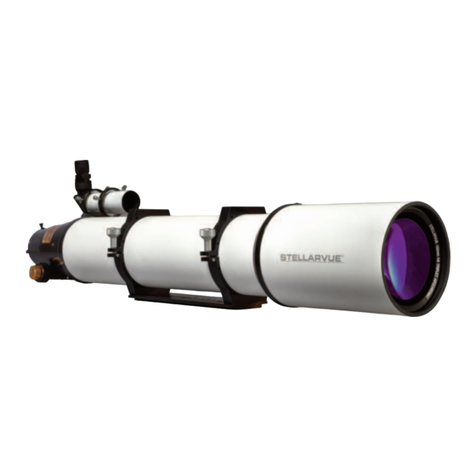
Stellarvue
Stellarvue SVX152T PREMIER APO TRIPLET User manual

Stellarvue
Stellarvue SVQ100 User manual
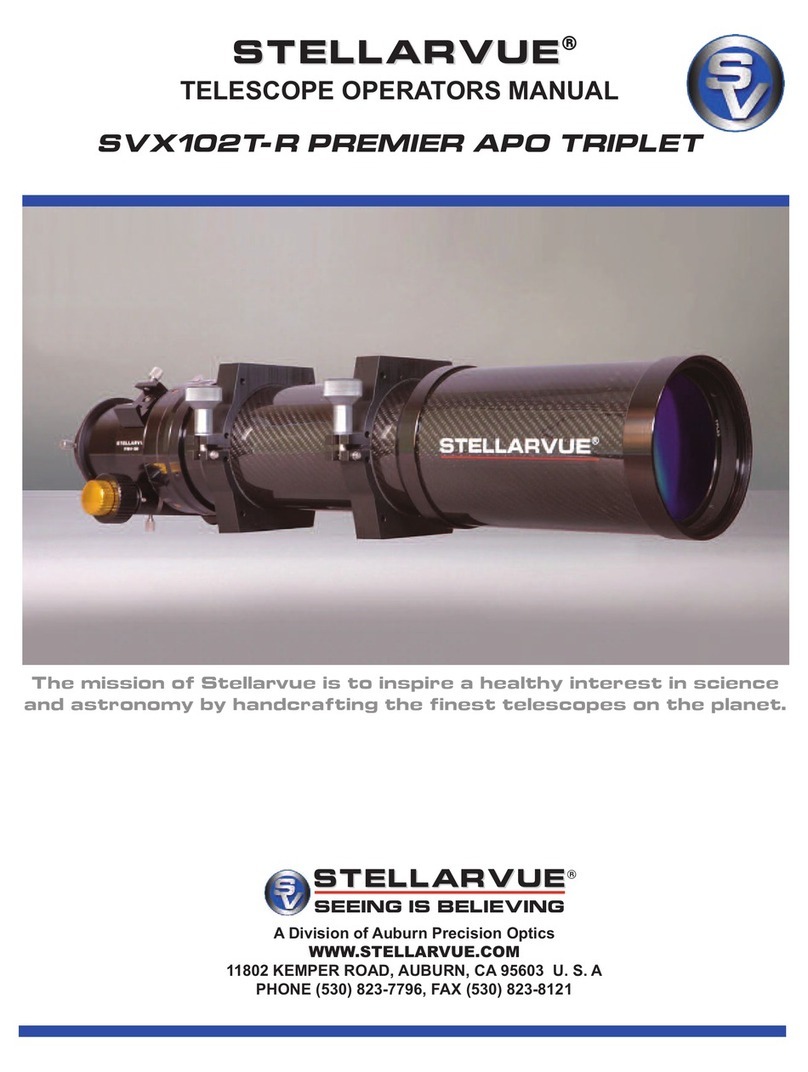
Stellarvue
Stellarvue SVX102T-R PREMIER APO TRIPLET User manual
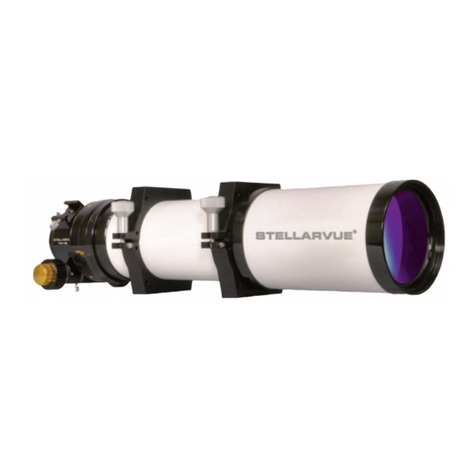
Stellarvue
Stellarvue SVX102T User manual
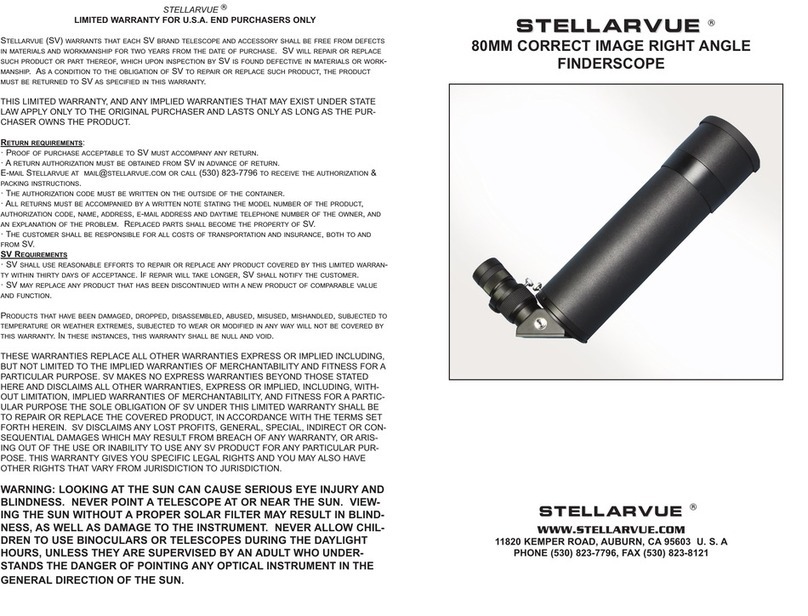
Stellarvue
Stellarvue F80 Series User manual
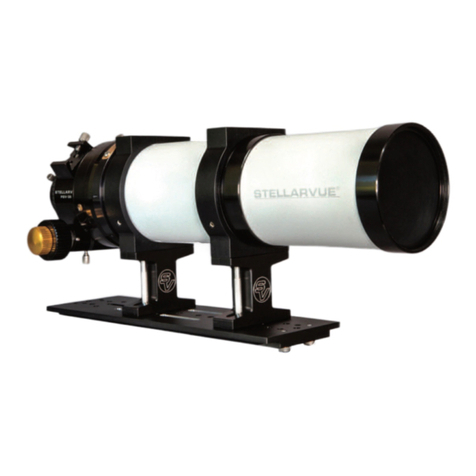
Stellarvue
Stellarvue PREMIER SVX80T-3SV User manual
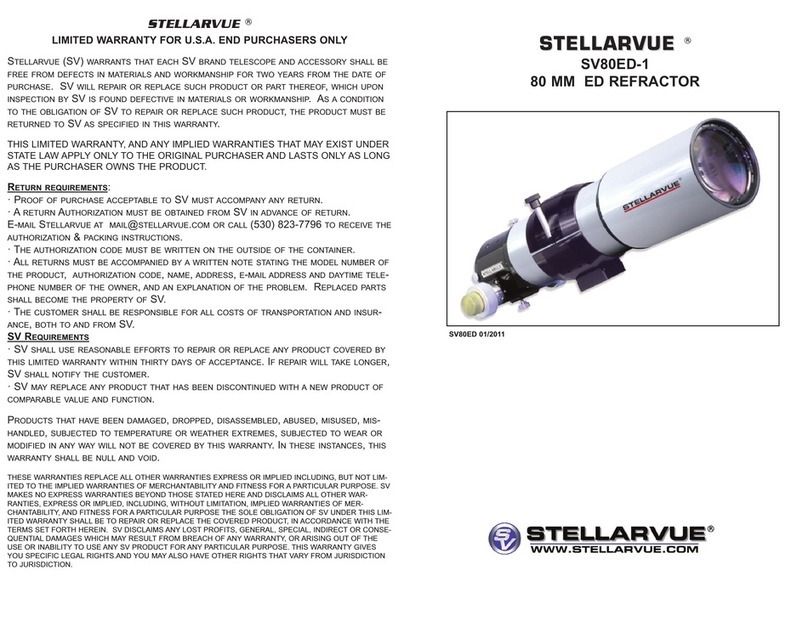
Stellarvue
Stellarvue SV80ED-1 User manual
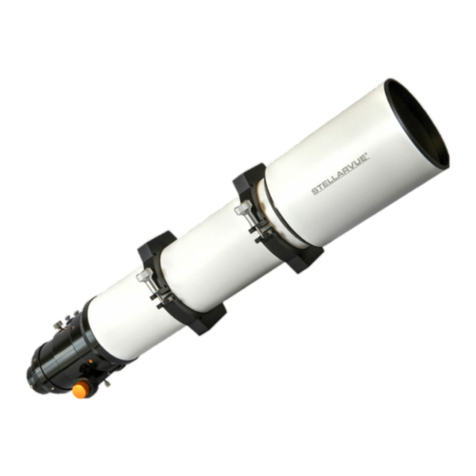
Stellarvue
Stellarvue SVX130T PREMIER User manual
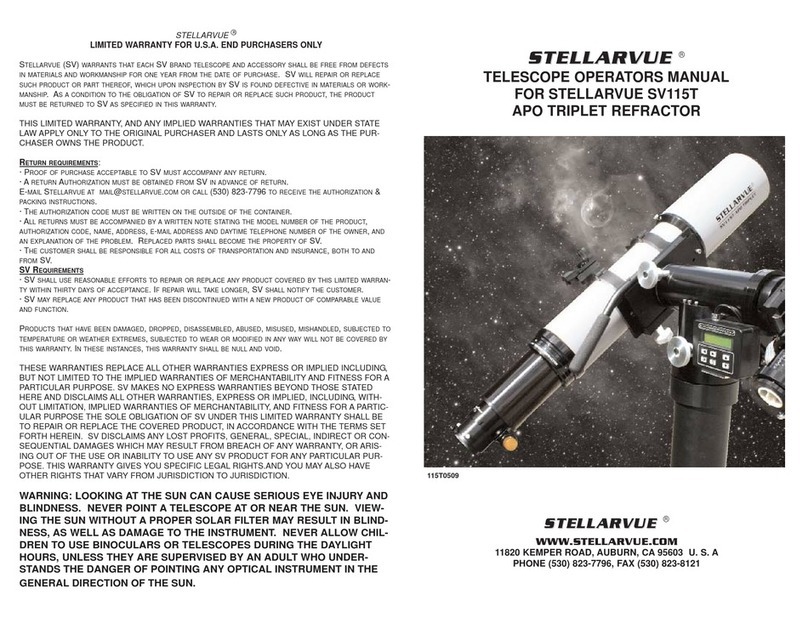
Stellarvue
Stellarvue SV115T User manual
